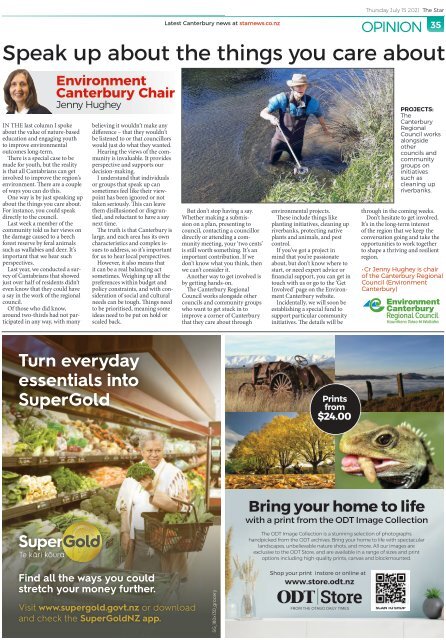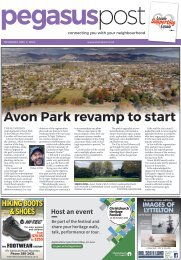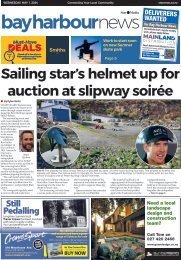The Star: July 15, 2021
Create successful ePaper yourself
Turn your PDF publications into a flip-book with our unique Google optimized e-Paper software.
since Environment Canterbury<br />
climate-change emergency<br />
by sea-level rise this century and threatened and facing increased<br />
our productive and protected land pressures due to river system<br />
Environment<br />
jeopardised by the arrival and change.<br />
spread of new, exotic weeds and Wetlands are also ecosystems<br />
Canterbury Chair<br />
pests from warmer climates. at-risk nationally and regionally,<br />
Jenny Hughey<br />
All these eventualities have degraded by draining, damming<br />
to be planned and prepared for, and diversion affecting their<br />
PROJECTS:<br />
<strong>The</strong><br />
and enhance that work.<br />
fleet hybrid or long-range electric<br />
and Environment Canterbury ability to sequester carbon,<br />
Canterbury<br />
IN<br />
That<br />
THE<br />
work<br />
last column<br />
included<br />
I spoke<br />
setting<br />
believing<br />
by 2022.<br />
it<br />
Carbon<br />
wouldn’t<br />
emissions<br />
make any<br />
from<br />
will remain in the vanguard of cleanse freshwater and mitigate<br />
Regional<br />
about the value of nature-based difference – that they wouldn’t<br />
up a climate-change integration air travel across the organisation<br />
these climate change efforts. flooding, as well as impacting on<br />
Council works<br />
education and engaging youth be listened to or that councillors One example is the $40 million biodiversity and mahinga kai.<br />
to<br />
programme<br />
improve environmental<br />
in the Long-term Plan<br />
would<br />
are offset<br />
just do<br />
via<br />
what<br />
our<br />
they<br />
own<br />
wanted.<br />
biodiversity<br />
alongside<br />
Waimakariri River flood<br />
With biosecurity, we are<br />
outcomes 2018-28, ensuring long-term. climate change<br />
Hearing<br />
programmes.<br />
other<br />
the views of the community<br />
According is invaluable. to a Madworld It provides report<br />
protection project, completed putting greater emphasis on the<br />
was <strong>The</strong>re actively is a special considered case to across be<br />
councils and<br />
late last year. <strong>The</strong> network of risks of new pests establishing<br />
community<br />
made workstreams, for youth, increasing but the reality visibility perspective in 2019, our and gross supports emissions our were<br />
floodgates and stopbanks will in Canterbury. Warming<br />
groups on<br />
is of that the science all Cantabrians and what can we get know decision-making.<br />
2253 tonnes of carbon dioxide<br />
protect half a million people and temperatures, changing soils and<br />
initiatives<br />
involved about the to impact improve of the climate region’s I (CO2) understand equivalent, that individuals compared with<br />
$8 billion of community and new land uses mean new weeds<br />
such as<br />
environment. change Canterbury, <strong>The</strong>re are and a couple liaising or removals groups that of speak 7883 tonnes up can of CO2-<br />
business assets from a possible especially, will be able to gain a<br />
cleaning up<br />
of on ways the issue you can with do iwi this. and regional sometimes equivalent feel through like their our viewpoint<br />
efforts has and been from ignored forestry not planting <strong>The</strong> last major flood was in More broadly, we have to<br />
efficiency<br />
“super flood”.<br />
better foothold across the region.<br />
riverbanks.<br />
partners, One way other is by local just speaking authorities up<br />
about and central the things government. you care about. taken across seriously. 2700 hectares. This can leave December 1957, when parts curb reliance on fossil fuels and<br />
For As instance, organisation, you could we speak have them <strong>The</strong> disillusioned changing climate or disgruntled,<br />
many and risks reluctant to life to and have livelihood a say Whether Kainga making were swamped a submis-by river <strong>The</strong>se alternatives, include things such like as electricity and Don’t hesitate to get involved.<br />
will pose But of don’t Coutts stop Island having Belfast a say. and environmental find environmentally projects. suitable through in the coming weeks.<br />
directly also made to the significant council. progress in<br />
addressing Last week our a member own greenhousegas<br />
emissions, told with us her our views on <strong>The</strong> we have truth seen is that how Canterbury occasional, is council, metres contacting per second a councillor (cumecs). riverbanks, transport. protecting native of the region that we keep the<br />
of the next in time. Canterbury. In recent years sion flow on a peaking plan, presenting at 3990 cubic to planting hydrogen, initiatives, to power cleaning our up public It’s in the long-term interest<br />
community<br />
the Christchurch damage caused building to a receiving beech a large, but and extreme, each area weather has its events own have directly<br />
<strong>The</strong><br />
or<br />
protection<br />
attending<br />
scheme<br />
a community<br />
has been<br />
plants and<br />
When<br />
animals,<br />
my predecessor<br />
and pest<br />
Steve<br />
conversation going and take the<br />
forest “market-leading” reserve by feral energy animals efficiency characteristics had huge effects and on complex residents issues<br />
infrastructure to address, so around it’s important the South is still worth something. It’s an If you’ve got a project in to shape a thriving and resilient<br />
and designed<br />
meeting,<br />
to defend<br />
your ‘two<br />
Christchurch<br />
cents’ control.<br />
Lowndes retired as chair of<br />
opportunities to work together<br />
such rating as of wallabies 5.0 out of and 6 in deer. the It’s year<br />
important to February that on we the hear National such for Island. us to hear local perspectives.<br />
from a flood of as much as 6500 this council late last year, he<br />
important contribution. If we mind that you’re passionate region.<br />
perspectives.<br />
Australian Built Environment<br />
However,<br />
<strong>The</strong> driest<br />
it also<br />
parts<br />
means<br />
of our<br />
that<br />
cumecs.<br />
highlighted some of the big<br />
region, don’t know what you think, then about, but don’t know where to<br />
Rating<br />
Last year,<br />
System<br />
we conducted<br />
New Zealand.<br />
a survey<br />
of Cantabrians that showed sometimes. Weighing up all the<br />
it can<br />
along<br />
be<br />
the<br />
a real<br />
Marlborough<br />
balancing act<br />
coast and we can’t<br />
Environment<br />
consider it.<br />
Canterbury’s changes on the way. He was<br />
start, or need expert advice or • Cr Jenny Hughey is chair<br />
<strong>The</strong> building’s features include across much of the Canterbury<br />
Another<br />
leadership<br />
way<br />
of<br />
to<br />
biodiversity<br />
get involved<br />
and<br />
is financial<br />
optimistic<br />
support,<br />
we<br />
you<br />
would<br />
can get<br />
be<br />
in<br />
able to<br />
of the Canterbury Regional<br />
just over half of residents didn’t preferences within budget and by getting<br />
biosecurity<br />
hands-on.<br />
programmes is also<br />
touch with<br />
deal with<br />
us or<br />
the<br />
go to<br />
“pressing<br />
the ‘Get<br />
issues” Council of (Environment<br />
even<br />
184 solar<br />
know<br />
panels<br />
that they<br />
which<br />
could<br />
can<br />
have policy<br />
Plains,<br />
constraints,<br />
are expected<br />
and<br />
to<br />
with<br />
get<br />
consideration<br />
even<br />
<strong>The</strong> underpinned Canterbury by Regional climate-change<br />
Involved’<br />
climate<br />
page<br />
change<br />
on the Environment<br />
I share his website. confidence. As a<br />
and sustainability. Canterbury)<br />
a<br />
generate<br />
say in the<br />
more<br />
work<br />
than<br />
of the<br />
55,000<br />
regional<br />
drier. North-westerly<br />
of social and cultural<br />
storms are<br />
Council concerns. works alongside other<br />
council. kilowatt hours of electricity per needs predicted can be to tough. become Things more need intense,<br />
councils and community groups Incidentally, we will soon be<br />
year. Of those who did know, to with be prioritised, torrential meaning alpine rainstorms<br />
Canterbury’s distinct braided community, and as a council,<br />
It’s a year since Environment some who rivers want to and get unique stuck in wetlands to face Canterbury<br />
establishing we are a taking special some fund bold to steps to<br />
around <strong>The</strong>re two-thirds has been a had 26% not reduction participated<br />
per staff<br />
ideas turning need our to be braided put on rivers hold or into improve many a corner challenges. of Canterbury <strong>The</strong> rivers form support ensure particular we are community in a better place to<br />
declared<br />
member in any way, in with emissions many scaled a roaring back. climate-change rapids, fuelling landslides that a they vital care ecological about through emergency<br />
link and provide initiatives. cope <strong>The</strong> with details the changing will be climate<br />
since 30 June 2010. We now have and causing widespread erosion. an abundant food supply and and the tests it will set us. But<br />
access to JENNY electric HUGHEY and hybrid explains what Canterbury’s coastal<br />
nesting grounds for 26 species of by sea-level there will rise always this century be a need and to do threatened and facing increased<br />
vehicles the and council hope has to have been half doing. our communities will be threatened native birds – most classified as our more. productive and protected land<br />
<strong>The</strong> formal declaration of a<br />
state of climate emergency across<br />
Canterbury was one of the most<br />
serious, and colourful, moments<br />
in the regional council’s more than<br />
30-year history.<br />
A year ago this Saturday,<br />
at 11.49am, Environment<br />
Canterbury became New Zealand’s<br />
first council to proclaim such an<br />
emergency, formally dedicating<br />
itself to consideration of climate<br />
change at the heart of all it does.<br />
<strong>The</strong> declaration highlighted<br />
that all the work Environment<br />
Canterbury does – from<br />
freshwater management to<br />
biodiversity and biosecurity,<br />
transport and urban development<br />
to air quality, and also regional<br />
leadership – has a climate change<br />
focus.<br />
Currently, under the Resource<br />
Management Act, regional<br />
councils are required only to adapt<br />
to climate change, not mitigate<br />
it – that responsibility is the<br />
Government’s, but could change.<br />
Even in ‘adapt mode’ many<br />
of Environment Canterbury’s<br />
existing policies and plans already<br />
contribute to reduced emissions.<br />
In declaring the climate<br />
emergency, the Council noted it<br />
would continue to show leadership<br />
on climate-change and do so<br />
without adding new programmes<br />
at ratepayers’ expense. It also gave<br />
staff a clear mandate to continue<br />
and enhance that work.<br />
That work included setting<br />
up a climate-change integration<br />
programme in the Long-term Plan<br />
2018-28, ensuring climate change<br />
was actively considered across<br />
workstreams, increasing visibility<br />
of the science and what we know<br />
about the impact of climate<br />
change on Canterbury, and liaising<br />
on the issue with iwi and regional<br />
partners, other local authorities<br />
and central government.<br />
As an organisation, we have<br />
also made significant progress in<br />
addressing our own greenhousegas<br />
emissions, with our<br />
Christchurch building receiving a<br />
“market-leading” energy efficiency<br />
rating of 5.0 out of 6 in the year<br />
to February on the National<br />
Australian Built Environment<br />
Rating System New Zealand.<br />
<strong>The</strong> building’s features include<br />
184 solar panels which can<br />
generate more than 55,000<br />
kilowatt hours of electricity per<br />
year.<br />
<strong>The</strong>re has been a 26% reduction<br />
per staff member in emissions<br />
since 30 June 2010. We now have<br />
access to electric and hybrid<br />
vehicles and hope to have half our<br />
Latest Canterbury news at starnews.co.nz<br />
Environment<br />
Canterbury Chair<br />
Jenny Hughey<br />
fleet hybrid or long-range electric<br />
by 2022. Carbon emissions from<br />
air travel across the organisation<br />
are offset via our own biodiversity<br />
programmes.<br />
According to a Madworld report<br />
in 2019, our gross emissions were<br />
2253 tonnes of carbon dioxide<br />
(CO2) equivalent, compared with<br />
removals of 7883 tonnes of CO2-<br />
equivalent through our efficiency<br />
efforts and from forestry planting<br />
across 2700 hectares.<br />
<strong>The</strong> changing climate will pose<br />
many risks to life and livelihood<br />
in Canterbury. In recent years<br />
we have seen how occasional,<br />
but extreme, weather events have<br />
had huge effects on residents and<br />
infrastructure around the South<br />
Island.<br />
<strong>The</strong> driest parts of our region,<br />
along the Marlborough coast and<br />
across much of the Canterbury<br />
Plains, are expected to get even<br />
drier. North-westerly storms are<br />
predicted to become more intense,<br />
with torrential alpine rainstorms<br />
turning our braided rivers into<br />
roaring rapids, fuelling landslides<br />
and causing widespread erosion.<br />
Canterbury’s coastal<br />
communities will be threatened<br />
jeopardised by the arrival and<br />
spread of new, exotic weeds and<br />
pests from warmer climates.<br />
All these eventualities have<br />
to be planned and prepared for,<br />
and Environment Canterbury<br />
will remain in the vanguard of<br />
these climate change efforts.<br />
One example is the $40 million<br />
Waimakariri River flood<br />
protection project, completed<br />
late last year. <strong>The</strong> network of<br />
floodgates and stopbanks will<br />
protect half a million people and<br />
$8 billion of community and<br />
business assets from a possible<br />
“super flood”.<br />
<strong>The</strong> last major flood was in<br />
December 1957, when parts<br />
of Coutts Island in Belfast and<br />
Kainga were swamped by river<br />
flow peaking at 3990 cubic<br />
metres per second (cumecs).<br />
<strong>The</strong> protection scheme has been<br />
designed to defend Christchurch<br />
from a flood of as much as 6500<br />
cumecs.<br />
Environment Canterbury’s<br />
leadership of biodiversity and<br />
biosecurity programmes is also<br />
underpinned by climate-change<br />
concerns.<br />
Canterbury’s distinct braided<br />
rivers and unique wetlands face<br />
many challenges. <strong>The</strong> rivers form<br />
a vital ecological link and provide<br />
an abundant food supply and<br />
nesting grounds for 26 species of<br />
native birds – most classified as<br />
OPINION 35<br />
Speak up about the things you care about<br />
Turn everyday<br />
essentials into<br />
SuperGold<br />
Find all the ways you could<br />
stretch your money further.<br />
Visit www.supergold.govt.nz or download<br />
and check the SuperGoldNZ app.<br />
SG_180x130_grocery<br />
Thursday <strong>July</strong> <strong>15</strong> <strong>2021</strong> <strong>The</strong> <strong>Star</strong><br />
pressures due to river system<br />
change.<br />
Wetlands are also ecosystems<br />
at-risk nationally and regionally,<br />
degraded by draining, damming<br />
and diversion affecting their<br />
ability to sequester carbon,<br />
cleanse freshwater and mitigate<br />
flooding, as well as impacting on<br />
biodiversity and mahinga kai.<br />
With biosecurity, we are<br />
putting greater emphasis on the<br />
risks of new pests establishing<br />
in Canterbury. Warming<br />
temperatures, changing soils and<br />
new land uses mean new weeds<br />
especially, will be able to gain a<br />
better foothold across the region.<br />
More broadly, we have to<br />
curb reliance on fossil fuels and<br />
find environmentally suitable<br />
alternatives, such as electricity and<br />
hydrogen, to power our public<br />
transport.<br />
When my predecessor Steve<br />
Lowndes retired as chair of<br />
this council late last year, he<br />
highlighted some of the big<br />
changes on the way. He was<br />
optimistic we would be able to<br />
deal with the “pressing issues” of<br />
climate change and sustainability.<br />
I share his confidence. As a<br />
community, and as a council,<br />
we are taking some bold steps to<br />
ensure we are in a better place to<br />
cope with the changing climate<br />
and the tests it will set us. But<br />
there will always be a need to do<br />
more.


















